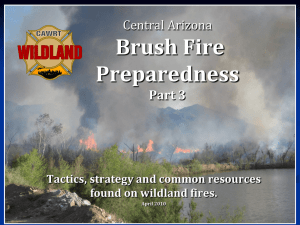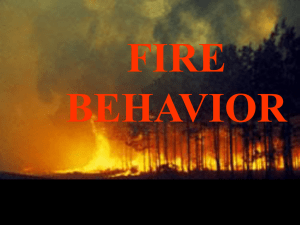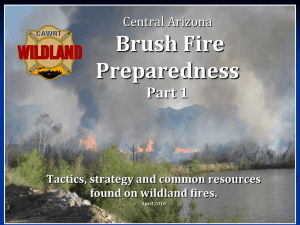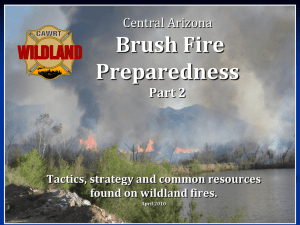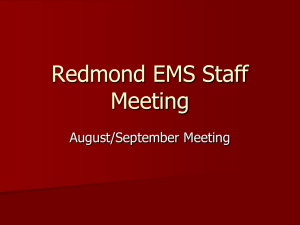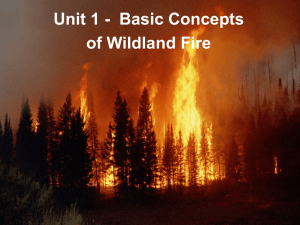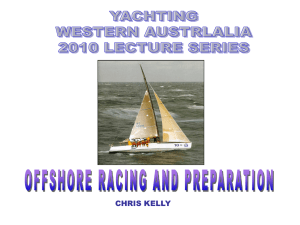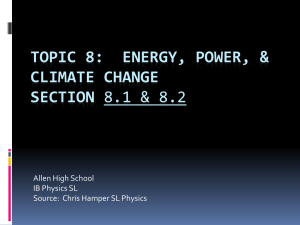NCF - Training Spot
advertisement
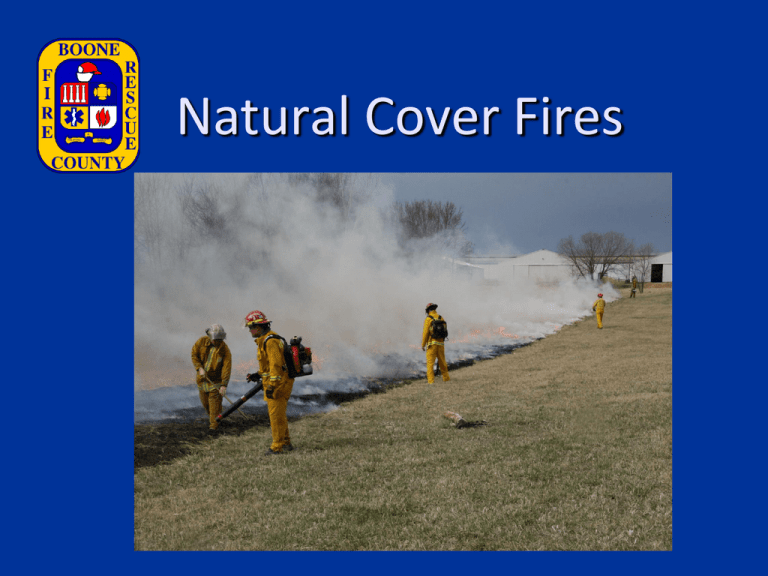
Natural Cover Fires view from the west View looking west at the Head of the Fire TOPICS - Wildland PPE - Apparatus - Wildland Tools - Topography and Fuels - Scene Size-Up - Fire Attack - Safety WILDLAND PERSONAL PROTECTIVE EQUIPMENT WILDLAND PPE Lightweight Less restrictive Bunker Gear Issues WILDLAND PPE Able to withstand radiant heat Constructed of Nomex and Kevlar Will burn in direct contact with fire WILDLAND PPE Your wildland PPE should consist of: Protective Boots Wildland Pants Wildland Coat Gloves Helmet Eye Protection WILDLAND PPE Wildland Boots should be: Leather Eight inches high Comfortable for the terrain Wildland Boots should not: Be made of synthetic material Have steel toes WILDLAND TOOLS Hand Tools Shovels Axes Pulaski Fire Swatter (Flapper) Rakes Mechanical Tools Back Pack Pumps Indian Packs Drip Torch Power Tools Chain Saw Blower Other Tools Chains Flashlights Forestry Hose Nozzles Flares Thermal Imaging Camera Tool Care Clean all tools and hose lines after each use Check for cracks and splits Use Linn seed oil on wooden handles Keep tools sharp Refill all water, foam, and fuel tanks after use Apparatus BRUSH TRUCKS Light Weight Four Wheel Drive Designed for Wildland incidents Mobile to remote locations Foam capabilities Engines Additional tools Additional water Drafting Capabilities Structural Protection Foam Capabilities Stage on Roadways Tankers Additional Water Additional Tools Structural Protection Stage on Roadways General Rules Keep warning lights on Command apparatus/post should be easily identifiable Never ride on the outside of a moving apparatus Driver’s must maintain visual contact with crew working outside of the apparatus Stage ALL apparatus on the roadways Be mindful bridge weights on rural roads Keep doors shut and windows up in apparatus First Priority Life Safety then structural protection Staging Watch for overhead power lines Watch for damages trees/limbs Stay clear of LPG or fuel storage tanks Tactically position apparatus for structural protection Stage apparatus facing escape routes FUELS, WEATHER, AND TERMS Fuels Fuel The most common fuels consumed during a natural cover fire: Any flammable or combustible substance available for fire consumption Grass, brush, trees, and crops Other fuels encountered: Structures, vehicles, farm equipment, Hazmat, etc. Fuels Surface Fuels Aerial Fuels Fuels found on the ground Fuels on tops of trees and brush Ladder Fuels Fuels connecting surface fuels to aerial fuels Fuels Light Fuels Medium Fuels Short grass or light brush Brush up to 6 feet high Heavy Fuels Thick/dense fuels over 6 feet high Weather - - Wind direction and velocity Low humidity High temperatures Lots of sunshine Low moisture Time of day Day of week Terms Origin – Area where the fire started Head – Part of the fire with the greatest rate of speed Heel – Opposite end of the head. Also referred to as the “rear” Unburned – Area of Unburned fuel outside or adjacent to the involved area Black – area that the fire has consumed Flanks – The sides of the fire, roughly parallel to the main direction of the fire spread. Scene Size-Up Windshield Size-Up Establish Command Ask yourself these questions: What is burning? Fuel type/load How much area is currently involved? How much has burned already? Windshield Size-Up (continued) How fast is the fire moving? Are there any exposure concerns? Do I need additional resources? Am I staged in a safe area? Fire Attack Direct Attack Hierarchy of tool selection of a crew for “typical” light to medium fuel natural cover fires: Blower Rake Water/Foam Direct Attack Establish a safe anchor point prior to starting fire attack Start attack by the heel or a natural barrier Direct Attack Work in tandem to prevent fire from reigniting Give ongoing reports to command Direct Attack - Crew Crew Leader - Obtains portable radio, rake, and two flares Crew Member - Obtains the blower and its extension tube Additional Crew Member - Obtains an Indian pack/pump pack Brush Truck Operations Crew Leader - Walks ahead of truck as a spotter, obtains portable Crew Member #1 - Starts pump, drives truck watching other crew members Crew member #2 - Deploys crosslay, walks along truck extinguishing flames Indirect Attack Controlling the fire by constructing a control line along natural barriers or by removing/burning unburned fuel in the fire’s path Natural Barriers Creeks Rivers Streams Dirt Rock areas Manmade Barriers Roadways Parking Ditches lots Back Burning Method involves burning a fire line ahead of the fire to eliminate fuels for the fire to consume Indirect Attack - Crew Crew Leader - Obtains portable, drip torch, and two flares Crew Member - Obtains blower and extension tube or a water pack Additional Crew Member - obtains a rake After the Fire Double check for hot spots Check back in with the IC – entire crew Rehab tools Refill apparatus Terminate command Safety Safety Solid Incident Command Accountability Communications Escape Routes Safety Zones Safety In the majority of NCF incidents, there are no lives at risk until the first firefighter arrives Prepare for the worst case scenario Place experienced personnel in crew leader and incident commander roles Safety Special Considerations Fire moving up hills Power lines Fences Above ground fuel tanks Falling Timber/Limbs Urban Interface Safety Concerns Be mindful of change in wind pattern Watch for spot fires over your line Unclear assignment Crew fatigue Reminders Hydrate and rehab as needed Park on roadways Do not ride outside of a moving apparatus Stay with your crew Stay focused Call for additional recourses early Summary Priorities Life Safety Incident Stabilization Property Conservation SCENARIOS Windshield View
